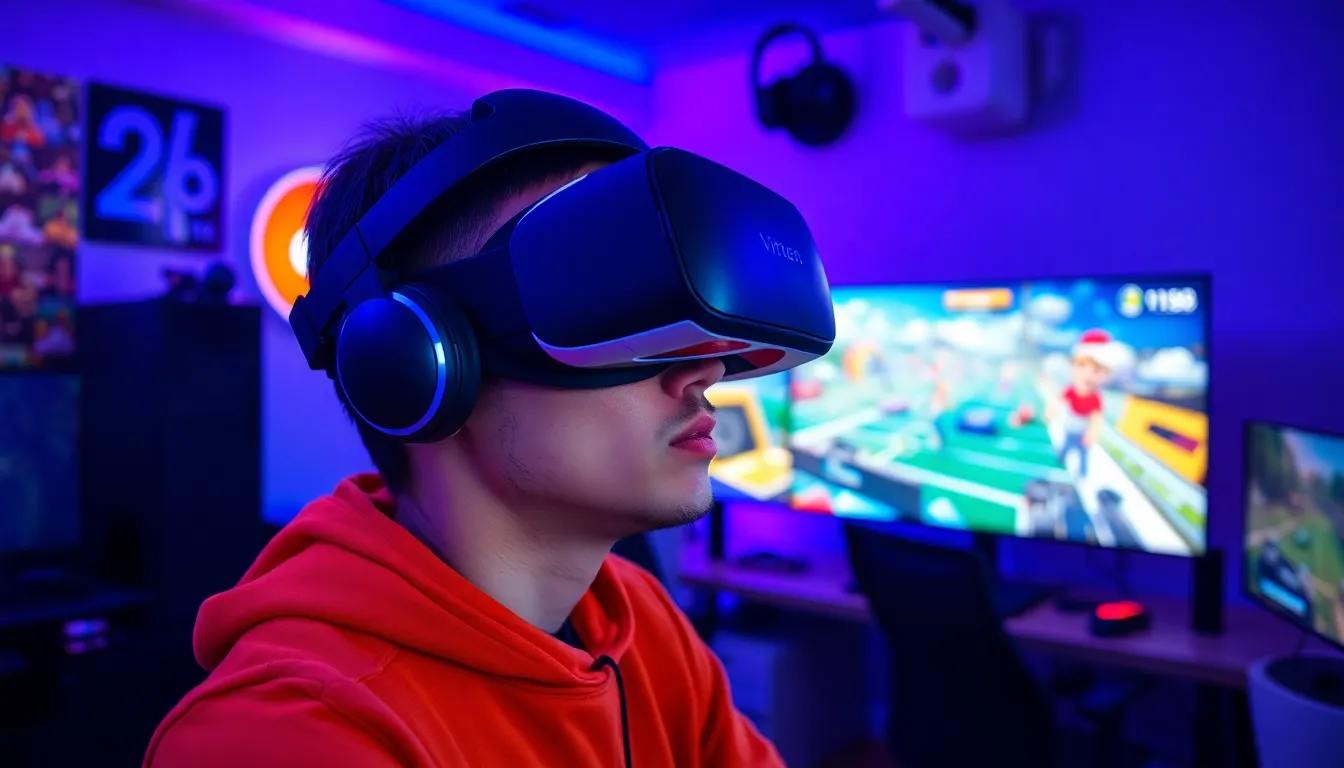Table of Contents
ToggleGaming has come a long way since the days of pixelated screens and simple sound effects. Today, technology shapes every aspect of gaming, from stunning graphics and immersive soundscapes to advanced AI and virtual reality experiences. Gamers now find themselves in rich, interactive worlds that push the boundaries of creativity and storytelling.
As technology evolves, so do the ways players engage with their favorite titles. Innovations like cloud gaming and augmented reality are transforming how games are played and shared. With each new development, the gaming landscape becomes more dynamic and exciting, inviting both seasoned players and newcomers to explore the endless possibilities.
Overview of Technology in Gaming
Technology plays a crucial role in shaping the gaming industry. Innovations in hardware and software enhance user experiences, creating richer and more engaging environments.
- Graphics and Visuals:
- Graphics cards, such as NVIDIA’s RTX series and AMD’s Radeon, push the boundaries of realism.
- Game engines like Unreal Engine and Unity enable developers to create detailed textures and lifelike animations.
- Artificial Intelligence:
- AI governs non-playable characters (NPCs), making them more responsive and intelligent.
- Machine learning algorithms analyze player behavior, enhancing difficulty levels and personalizing gameplay.
- Virtual Reality (VR) and Augmented Reality (AR):
- VR headsets, such as Oculus Quest and HTC Vive, create immersive experiences.
- AR applications, like Pokémon GO, overlay digital elements onto the real world, enriching interaction.
- Cloud Gaming:
- Services like Google Stadia and NVIDIA GeForce NOW allow gaming without powerful local hardware.
- Streaming technology minimizes latency, enabling seamless gameplay across various devices.
- Mobile Gaming Technology:
- Smartphones and tablets have shifted the gaming landscape, making gaming accessible anywhere.
- Advances in mobile processors and graphics capabilities support high-quality games on portable devices.
- Social and Connectivity Features:
- Online multiplayer platforms promote community engagement through voice chat and forums.
- Social media integrations allow easy sharing of gameplay experiences and in-game achievements.
- Cross-Platform Play:
- Cross-platform compatibility enables players on different devices to compete, broadening the gaming community.
- Titles like Fortnite and Call of Duty support multiple platforms, increasing user engagement.
- Esports Technology:
- Broadcasting tools enhance spectatorship, providing real-time statistics and interactivity.
- Dedicated servers ensure smooth gameplay during competitive events.
Technological advancements continue to redefine gaming, enriching experiences and expanding horizons for both developers and players.
Evolution of Gaming Technology

The evolution of gaming technology highlights key advancements that transformed the gaming experience. Innovations in graphics, virtual reality, and connectivity significantly shaped how players interact with games.
From 2D to 3D Graphics
Transitioning from 2D to 3D graphics marked a pivotal moment in gaming technology. Early video games featured simple sprites and basic animations. The introduction of 3D graphics in the 1990s allowed for more complex environments and character models. Textures, lighting effects, and shading techniques enhanced realism, drawing players into immersive worlds. Notable advancements include the development of polygonal modeling, which enabled lifelike character representations, and the use of graphics processing units (GPUs) that handled extensive graphical computations efficiently. Titles like “Doom” and “Final Fantasy VII” showcased the potential of 3D graphics, expanding creative possibilities for developers and thrilling players.
The Rise of Virtual Reality
Virtual reality (VR) transformed gaming by immersing players in fully interactive 3D environments. Initial attempts at VR in the 1980s and 1990s laid the groundwork for today’s innovations. The release of consumer VR headsets, such as the Oculus Rift and HTC Vive, brought advanced technologies to mainstream audiences. VR allows players to experience games in ways traditional formats cannot, utilizing motion tracking, haptic feedback, and spatial audio. Popular VR titles, like “Beat Saber” and “Half-Life: Alyx,” exemplify the capabilities of this technology, offering unparalleled engagement and interactivity. As advancements in VR continue, such as improved hardware and more accessible pricing, its presence in the gaming landscape expands further, captivating a diverse range of players.
Current Trends in Gaming Technology
Current trends in gaming technology reflect ongoing innovations that enhance player experiences and expand the gaming landscape’s capabilities.
Cloud Gaming Services
Cloud gaming services enable players to access games remotely without requiring powerful local hardware. Through streaming technology, players can enjoy high-quality gaming on various devices, including smartphones and tablets. Services like NVIDIA GeForce NOW and Xbox Cloud Gaming offer vast libraries, allowing players to engage with their favorite titles anytime, anywhere. Additionally, the benefits of cloud gaming, such as reduced load times and seamless updates, enhance user convenience and accessibility. The growth of 5G networks further supports the expansion of cloud gaming, providing faster, more reliable connections that improve gameplay quality.
Artificial Intelligence in Games
Artificial intelligence (AI) in games has advanced significantly, personalizing experiences and enriching player engagement. AI-driven algorithms analyze player behaviors, allowing for tailored gameplay that adapts to individual skill levels and preferences. Non-playable characters (NPCs) utilize sophisticated AI to react intelligently to player actions, creating dynamic and immersive environments. Furthermore, game development benefits from AI through procedural content generation, enabling the creation of expansive worlds and intricate narratives with reduced manual effort. The integration of machine learning in gaming also fosters more realistic enemy behaviors, enhancing the challenge and excitement of gameplay.
Impact of Technology on Gaming Culture
Technological advancements significantly influence gaming culture, shaping community interaction and competitive experiences. Innovations in connectivity, streaming services, and community engagement tools redefine how gamers connect and share their experiences.
Community Engagement through Technology
Technology enhances community engagement within gaming cultures. Online platforms and social media facilitate connections among players, allowing them to share experiences, strategies, and victory celebrations. Features like user-generated content, forums, and voice chat foster collaboration, generating a sense of belonging. Major gaming events, such as conventions and competitions broadcast online, draw vast audiences, promoting inclusivity. Many games now incorporate features like clans and guilds, enabling players to build relationships and collaborate on challenges.
Esports and Streaming
Esports technology transforms competitive gaming into a mainstream phenomenon. Professional gaming tournaments attract millions of viewers globally, with platforms like Twitch and YouTube Gaming enabling live streaming of events. These platforms create interactive viewing experiences, allowing players to engage with their favorite esports teams and communicate in real-time. High-definition streaming and advanced broadcasting techniques offer polished presentations, enhancing spectator enjoyment.
Streaming also enables aspiring gamers to showcase their skills and build personal brands. Gamers often leverage social media to amplify their reach, creating unique communities around their gameplay. Brands recognize this potential and increasingly sponsor esports events, further blurring the line between traditional sports and esports. Overall, technology fosters a vibrant esports ecosystem that’s reshaping gaming culture in significant ways.
Future of Technology in Gaming
Emerging technologies promise to further revolutionize the gaming landscape, offering players deeper engagement and more immersive experiences. As the industry progresses, several innovations and challenges will shape the direction of gaming technology.
Innovations on the Horizon
- Artificial Intelligence: AI will advance, enabling more complex character interactions and personalized gameplay experiences. Expect NPCs to respond intelligently, adapting to player strategies, which enhances realism and immersion.
- Cloud Gaming: Cloud technology continues to grow, offering players access to expansive game libraries without reliance on powerful hardware. Increased bandwidth and reduced latency through 5G will enhance this experience, making games more accessible.
- Virtual Reality: VR technology is set to improve with higher resolutions and reduced motion sickness, elevating player immersion. New hardware developments, such as advanced haptic feedback systems, will create an even more engaging environment.
- Augmented Reality: AR applications will expand beyond mobile devices, allowing for interactive gameplay experiences in real-world environments. This technology encourages social interactions and community engagement through shared experiences.
- Gaming Hardware: Innovations in graphics processing units (GPUs) and gaming consoles will deliver stunning visuals and higher frame rates. Next-generation hardware will support more intricate game designs, driving the realism players expect.
- Blockchain Technology: Blockchain can enhance in-game economies by allowing players to trade, buy, or sell virtual assets securely. This technology provides ownership of digital items, which has implications for monetization and personalization in gaming.
Challenges Ahead
- Data Privacy and Security: As gaming becomes more connected, issues related to data security and privacy will escalate. Protecting players’ personal information will become vital for maintaining trust and safety within the gaming community.
- Digital Divide: Access to advancements in technology may not be uniform. Latency in adopting new technologies in various regions could create disparities, affecting how players engage with new gaming innovations.
- Content Moderation: With increased interactivity, issues like toxic behavior and harassment may proliferate. Developers face a challenge in creating safe environments, requiring robust moderation systems.
- Sustainability: The environmental impact of gaming technology, from production to energy consumption, raises questions about sustainable practices. The industry needs to address these concerns by adopting eco-friendly technologies and practices.
- Monetization Models: As technology evolves, so do challenges related to equitable monetization models. Developers must balance profitability with fair practices to ensure a positive user experience while sustaining business viability.
- Technological Dependency: Increasing reliance on complex technologies can create a barrier for less tech-savvy players. Ensuring accessibility for all gamers remains crucial amid rapid advancements.
The gaming industry stands at the forefront of technological innovation. As advancements continue to reshape experiences players have come to expect, the fusion of creativity and technology remains paramount. The rise of immersive technologies like virtual reality and augmented reality, alongside powerful AI-driven gameplay, is setting new standards for engagement.
Moreover, the accessibility brought by cloud gaming and mobile platforms ensures that gaming reaches broader audiences than ever before. As the landscape evolves, it’s clear that technology will play a crucial role in defining the future of gaming, creating opportunities for both players and developers alike. The journey of gaming technology is just beginning, and its potential is limitless.







